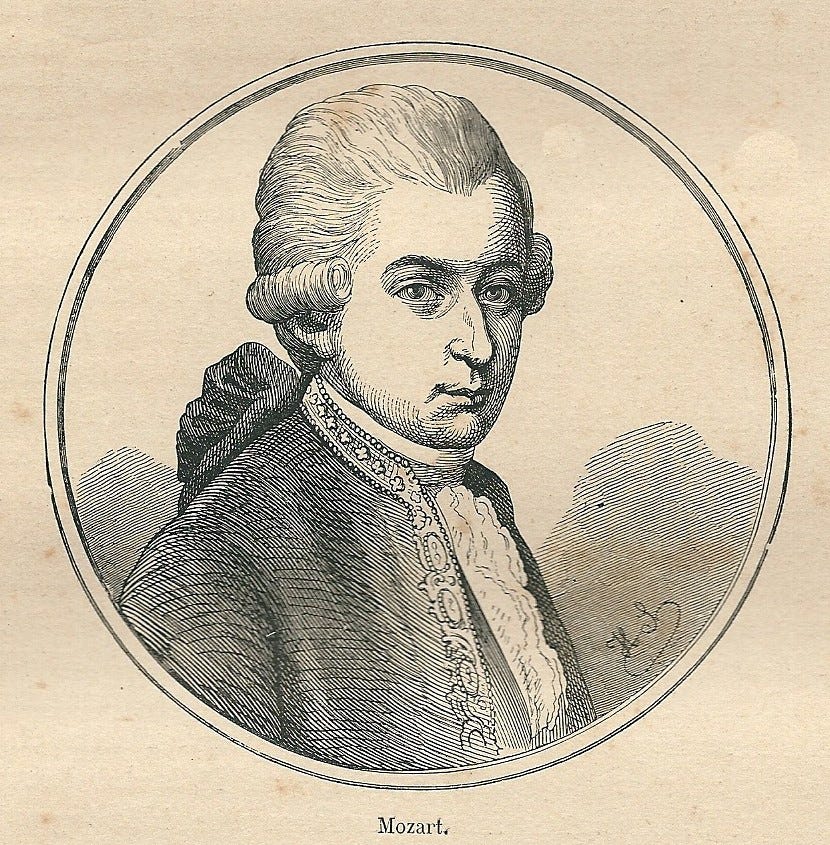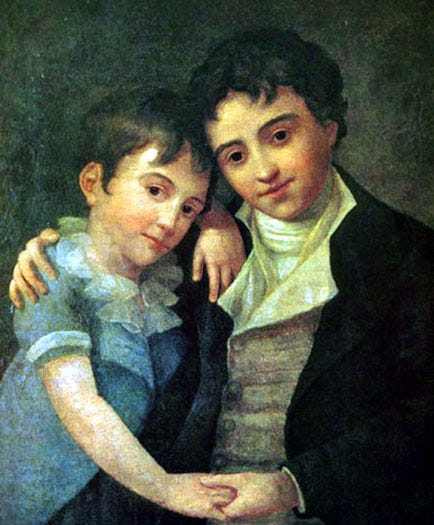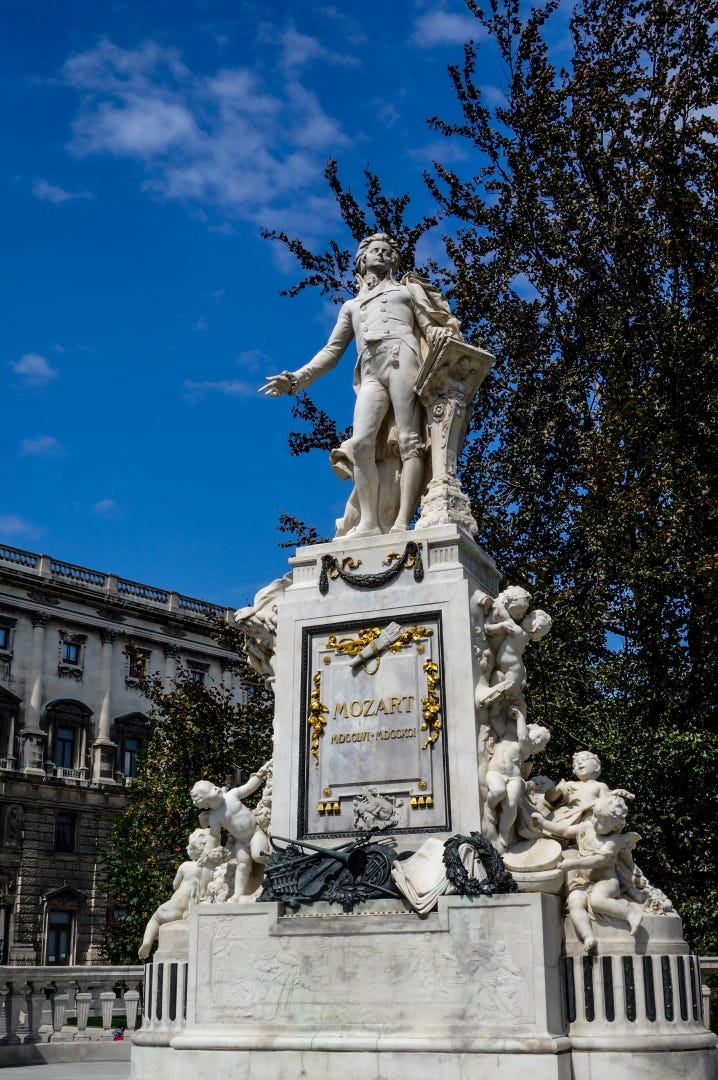Mozart. The very name reminds us of soaring arias, evocative melodies, and musical mastery. In this episode we explore 15 things you may not have known about the ingenious composer.
You can also download the podcast on all major platforms including Apple Podcasts and Spotify.
1.
The Köchel Catalogue, first completed in 1862, is a complete listing of all 626 of Mozart’s works, from his first composition at age 5 in 1761, Andante in C for Piano, to his final composition in 1791, Requiem in D in 1791
2.
Mozart’s compositions are known for hitting some of the highest and lowest notes in the vocal range. In The Magic Flute, the soprano must hit a high F in The Queen of the Night’s aria “The Vengeance of Hell Boils in my Heart,” and in the opera Abduction from the Seraglio, the bass soloist must, remarkably, sing a low D in Osmin’s Aria.
3.
You would need 202 hours or about eight and a half days of straight listening to get through Mozart’s entire body of work.
4.
Mozart’s sister, Nannerl, as she was nicknamed, was as gifted a musician as her brother, some say even more so. She accompanied her father and brother on their grand European tours as a child, and continued to play and compose until her father forbade it and insisted she marry instead. Unfortunately, none of her works have survived.
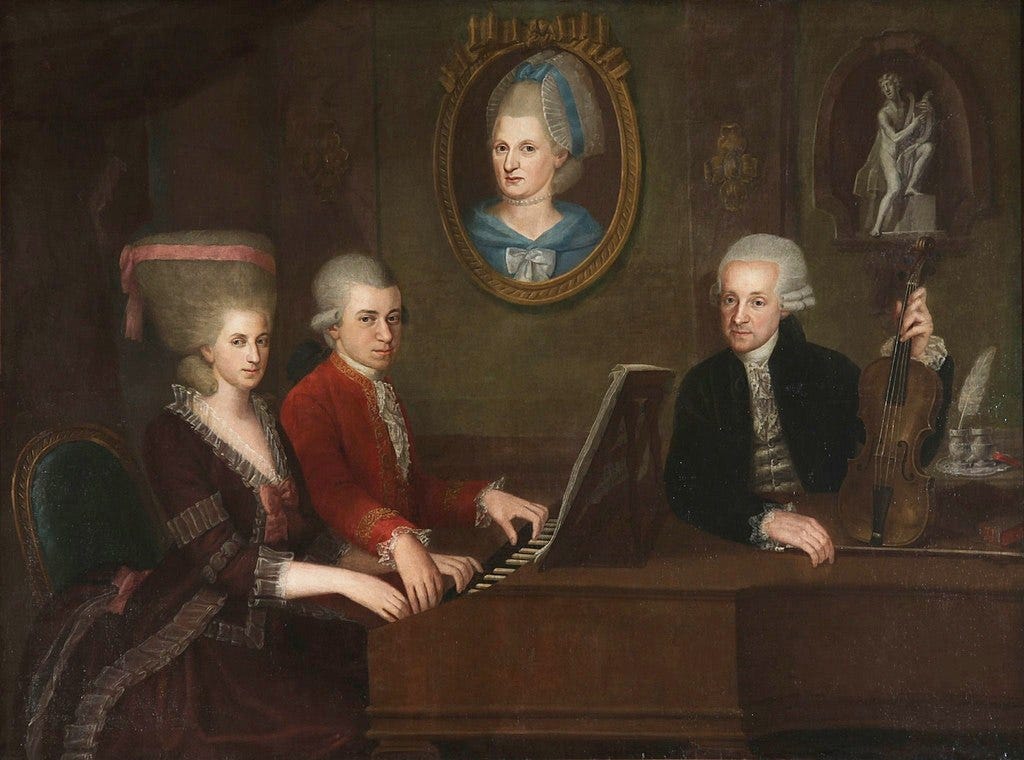
5.
Mozart had a pet starling, which, he claimed, could sing the opening bars to his Piano Concerto Number 17, K 453.
6.
Known as a bit of a trickster, Mozart never gave up the opportunity for a prank or practical joke, as we hear from Mozart describing his own antics at a performance of The Magic Flute, in a letter to a friend:
“...when Papageno's air accompanied by bells began, feeling such a strong impulse to play the bells myself for once, I played them a capital trick, for at Schikaneder's pause I made an arpeggio; he started, looked behind the scenes, and saw me. The second time the pause came, I did nothing, when he paused and would not proceed. I guessed his thoughts, and played a chord. He then struck the bells and said Haws Maul! (hold your tongue!) which made everybody laugh.”
7.
As a young child, Mozart performed for Queen Charlotte and her husband, King George III at Buckingham Palace During the 15 months he lived in London with his father and sister Nannerl in 1764.
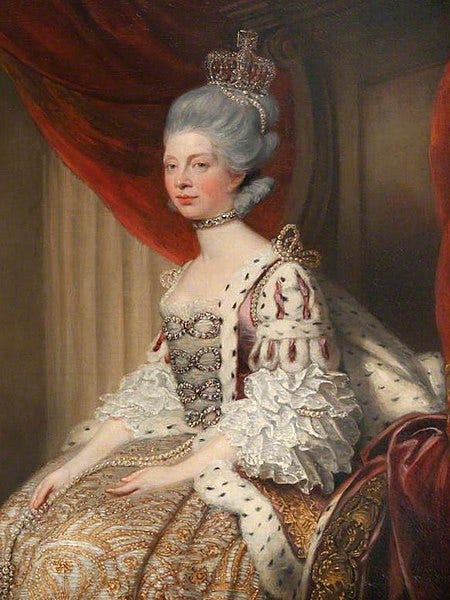
It seems both the Queen and Mozart made favourable impressions on each other, she declaring him likely to be one of Europe’s great composers, and he composing several sonatas for her at the age of eight.
8.
The relationship between contemporary composer Antonio Salieri and Mozart has long been the subject of speculation. In 1831, Russian poet, playwright and philosopher Alexander Pushkin wrote a one act play called Mozart and Salieri.
The play, a fictional exploration of the complicated relationship between the two composers, was based on the rumour that Salieri poisoned Mozart in a fit of jealous rage, causing his death.
In 1897, Nikolai Rimsky-Korsakov, a Russian composer, wrote an opera of the same name.
87 years later in 1984, the movie Amadeus was released, which further explored the rumour of Mozarts’ death at the hands of Salieri.
Poor Salieri - he is, it seems, more renowned for what he didn’t do, rather than what he did do: compose hundreds of brilliant compositions. There is certainly more proof of Salieri’s unbound admiration for Mozart and his talent than anything else:
“I received my first instruction in composition from the celebrated composer Giovanni Martini. From him I learned everything I know. But I owe my greatest instruction to Mozart.”
9.
Mozart was, famously, a member of The Freemasons, a brotherhood devoted to the ideals of the enlightenment - pursuit of knowledge, personal growth, rational thought, and philanthropy. He was in good company with the likes of George Washington, Goethe, and Voltaire also members of the fraternity.
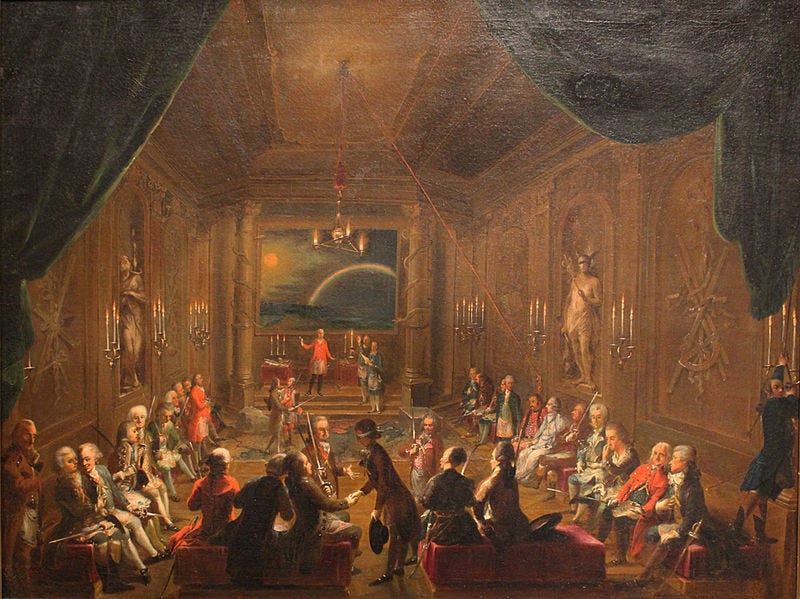
During his Freemason years, Mozart composed most of his biggest crowd-pleasers including Cosi Fan Tutte, Don Giovanni, The Marriage of Figaro, The Magic Flute and Requiem in D, a testament to the artistic inspiration Mozart found from his Freemason years.
10.
In 1790, Mozart and four others including Schikaneder, his librettist for The Magic Flute, collaborated on the opera Der Stein der Weisen, or The Philosopher’s Stone. The plot followed the quest for the Philosopher’s Stone which, legend has it, turns metal into gold, and promises eternal life.
The opera holds many similarities to The Magic Flute including elements of humour, fantasy, magical creatures, challenging quests, and similar characters; some say it was a model for The Magic Flute.
If the Philosopher’s Stone sounds familiar, that’s because it has appeared in many literary works over the centuries, from Geoffrey Chaucer’s Canterbury Tales, to J.K. Rowling’s Harry Potter and the Philosopher’s Stone. The stone’s transformational abilities may symbolize the quest for knowledge and truth, and the ability to improve and transform oneself, elements valued in Freemason lodges all over Europe at the time.
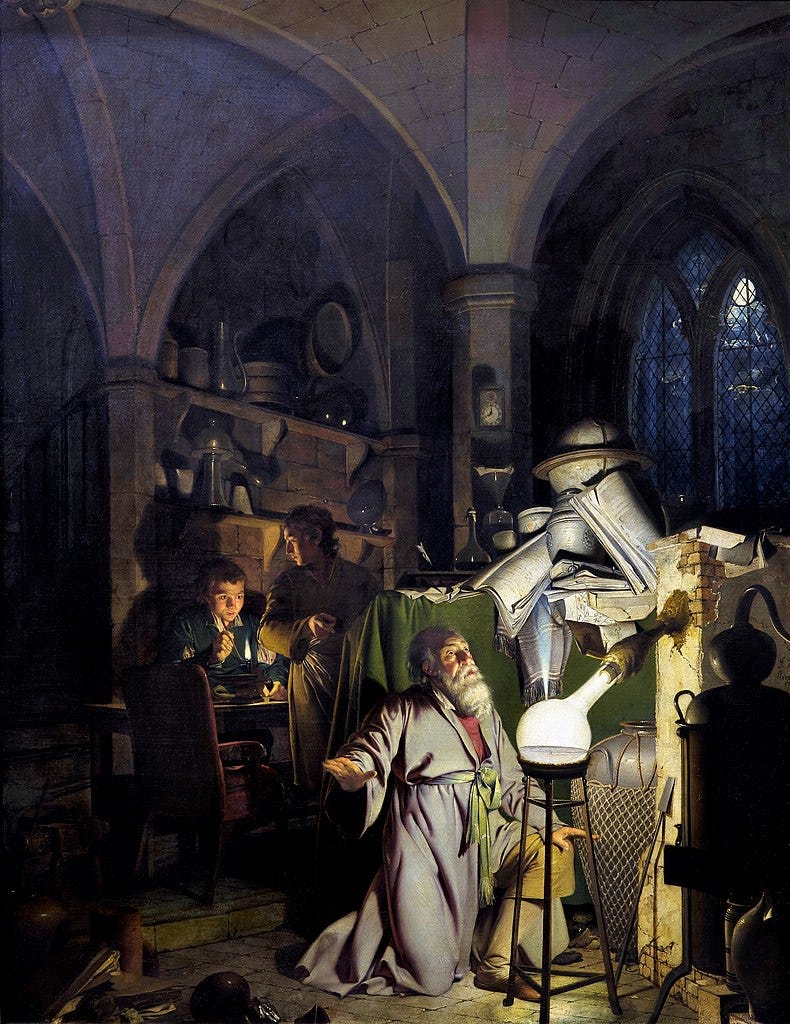
11.
Mozart and his wife, Constanze, had six children, but only two survived to adulthood: Karl Thomas Mozart, born in 1784, and Franz Xaver, born in 1791, just five months before the death of his father.
Of the two, Karl had an illegitimate daughter who died aged 10, and Franz never married or had children. Thus the Mozart family name died with the death of his two sons.
12.
Forever the joker, Mozart often signed his letters…
- Trazom Gnagflow
…his name backwards.
13.
Surprisingly, Mozart has a frog named after him. Eleutherodactylus amadeus is a small unassuming frog native to Southwestern Haiti and named after Mozart due to the whistling nature of its call, four notes in succession at night, and two notes at dawn.
14.
While much is made of the male composers of the classical period, Mozart was surrounded in his time by incredibly talented female composers and musicians including Marianna Martines, Maria Theresia von Paradis, and Josepha Auernhammer.
All three women were accomplished composers and musicians, and all three played regularly with Mozart at performances, often playing pieces he had written for them.
Given their renown in their day, one could ask why we know so little today about these brilliant and gifted women.
15.
When Mozart died in 1791, he was buried in a ‘common’ grave, so called as they were meant for anyone who was not nobility.
Unfortunately, there is no record of where this grave is, and to this day, the location of his final resting place remains a mystery.
However, there are many landmarks and monuments dedicated to Mozart in Vienna and Salzburg. Even Austria’s National Anthem is Mozart's Land of Mountains, Land of Streams from his Little Masonic Cantata.
On the occasion of his 250th birthday, January 27, 2006, bells from all the churches in Salzburg rang out at the exact moment of his birth.
Mozart may not have minded this anonymity in his death. He was quite resigned to its eventuality, writing:
“I have formed during the last few years such close relationships with this best and truest friend of mankind that death’s image is not only no longer terrifying to me, but is indeed very soothing and consoling, and I thank my God for graciously granting me the opportunity… of learning that death is the key which unlocks the door to our true happiness. I never lie down at night without reflecting that, young as I am, I may not live to see another day.”
While Mozart died over 230 years ago, his music lives on, and perhaps Beethoven, who himself rivals Mozart in greatness, said it best:
“Mozart is the greatest composer of all… The music of Mozart is of such purity and beauty that one feels he merely found it – that it has always existed as part of the inner beauty of the universe waiting to be revealed.”
Vancouver Opera presents The Magic Flute - October 21st to 29th, at the Queen Elizabeth Theatre. For tickets and more information visit VancouverOpera.ca
Credits:


Jane Potter - Writer and Narrator
Jane holds an MA in Critical and Creative writing from the University of Gloucestershire, and loves telling stories in all forms: She lives in Victoria, and when she isn’t busy reading and writing, she can be found running a small business, baking in the kitchen, or weeding the garden.
David Bloom - Voice of Wolfgang Amadeus Mozart and Ludwig van Beethoven
David Bloom is an actor, playwright, director, dramaturge, and fight choreographer. He has taught programs including stage combat, improvisation, Shakespeare, scene study, and new play creation at universities and art institutions throughout British Columbia.
Ashley Daniel Foot - Voice of Antonio Salieri
Ashley is Vancouver Opera’s Director of Engagement and Civic Practice.
Mack McGillivray - Editor
Mack is an audio producer, editor, and opera lover.
Music Credits:
VIII. Lacrimosa, and XIV. Communio from Requiem in D Minor by Wolfgang Amadeus Mozart
Performed by Wiener Hofmusikkapelle and the Wiener Philharmoniker (1950)
“Der Hölle Rache kocht in meinem Herzen”and “Papagena! Papagena! Papagena!” from Die Zauberflöte by Wolfgang Amadeus Mozart
Performed by Rita Streich, Maria Stader, Ernst Haefliger, Dietrich Fischer-Dieskau, Josef Griendl and Rias Symphonie-Orchester Berlin (1953)
“O, wie will ich triumphieren” from Die Entführung aus dem Serail by Wolfgang Amadeus Mozart
Performed by Gottlob Frick and The London Philharmonic Orchestra (1957)
III. Allegretto from Piano Concerto No. 17 in G major by Wolfgang Amadeus Mozart
I. Allegro from Piano Concerto No. 5 by Wolfgang Amadeus Mozart
I. Requiem II. Kyrie III. Dies Irae from Requiem in D minor by Wolfgang Amadeus Mozart
Performed by Vilnius University Choir, Tula State Choir, Chamber Choir MIREA, and Symphony Orchestra of the Moscow Conservatory
Land der Berge Land am Strome by Wolfgang Amadeus Mozart
Performed by United States Navy Band (2003)
I. Allegro from Eine Kleine Nachtmusik by Wolfgang Amadeus Mozart
Performed by Advent Chamber Orchestra (2005)





